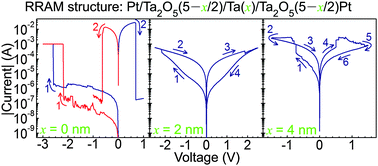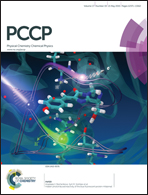Tuning the switching behavior of binary oxide-based resistive memory devices by inserting an ultra-thin chemically active metal nanolayer: a case study on the Ta2O5–Ta system†
Abstract
The common nonpolar switching behavior of binary oxide-based resistive random access memory devices (RRAMs) has several drawbacks in future application, such as the requirements for a high forming voltage, a large reset current, and an additional access device to settle the sneak-path issue. Herein, we propose the tuning of the switching behavior of binary oxide-based RRAMs by inserting an ultra-thin chemically active metal nanolayer, and a case study on Ta2O5–Ta systems is provided. The devices are designed to be Pt/Ta2O5(5 − x/2)/Ta(x)/Ta2O5(5 − x/2)/Pt with x = 0, 2, or 4 nm. The reference devices without the Ta nanolayer exhibit an expected nonpolar switching behavior with a high forming voltage of ∼−4.5 V and a large reset current of >10 mA. In contrast, a self-compliance bipolar switching behavior with a low forming voltage of ∼−2 V and a small reset current of <1 mA is observed after inserting a 2 nm Ta nanolayer. When the Ta nanolayer is increased to 4 nm, a complementary resistive switching (CRS) behavior is found, which can effectively settle the sneak-path issue. The appearance of CRS behavior suggests that a thin Ta nanolayer of 4 nm is robust enough to act as an inner electrode. Besides, the behind switching mechanisms are thoroughly discussed with the help of a transmission electron microscope and temperature-dependent electrical measurements. All these results demonstrate the feasibility of tuning switching behavior of binary oxide-based RRAMs by inserting an ultra-thin chemically active metal nanolayer and might help to advance the commercialization of binary oxide-based RRAMs.


 Please wait while we load your content...
Please wait while we load your content...